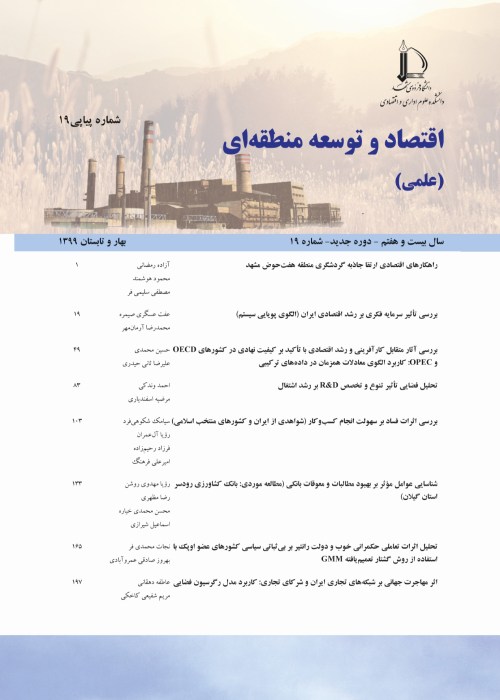Iran Export Position Analysis Based on Rugman model and Stable Market Share Index (CMS): a Case Study of Medicine and Steel Industry
Today, many companies and manufacturers are trying to enter the international market. Due to the new conditions of the current markets, it is no possible to enter such markets by trial and error. Therefore, considering the importance of this issue, this study tries to examine the effects of sanctions resulting from the Barjam and post-Barjam agreements on two selected industries that are domestically produced in Iran and traded internationally. In other words, if these industries are subject to sanctions, although they are not subject to sanctions, what will be the performance of these industries at the international level. Therefore, this study seeks to examine the variability of market share of these industries during sanctions or the absence of sanctions.
Since the economic activities of each country are not limited to the domestic environment, their competitiveness is not focused on the domestic environment, and each country has trade relations with different countries. One of the important factors for countries to choose trade partners is proximity and geographical proximity, the existence of economic and political relations between the two countries. Based on this, Ragman proposed a concept model called dual diamond for smaller countries, which was a combination of the internal characteristics of countries and their trading partners. Ragman states his model that a country's competitive advantage is due to the internal and external environment of countries, and the outcome of the diamond model factors in these two environments determines the competitiveness of countries.
According to the analysis of the effectiveness of two commodities drug and steel trade, one of which is not subject to sanctions and the other has been subject to sanctions, the use of sustainable market share index is more beneficial than other methods of evaluating comparative advantage and competitiveness. According to this index, a country's exports are successful if they can grow at least as much as global imports. This growth can be due to a focus on commodities whose consumption is increasing worldwide (commodity effect) or a focus on target markets whose consumption is growing faster than the global average (national effect) or the internal factors of the exporting country that increase Influence and share in target markets (competitive effect). Therefore, in order to estimate the above three effects, in this paper, the CMS method developed by Lamer and Stern has been used.
About of drug commodities, in 2016 and 2019, the commodity effect of commodity drugs has been positive for the countries under study. But in 2017 and 2018, the commodity effect of the drug has been negatived for all countries surveyed. Country effect in 2016 and 2017 was positive for Germany, Russia and Norway, and in 2019 was positive only in Russia. about of steel, in 2016 and 2019, the negative commodity effect was obtained, and in 2017 and 2018, it was positive for all countries. In other words, in 2016 and 2019, the growth of steel imports slowed down than the growth of imports of other goods in the world, and in 2017 and 2018, it also accelerated. Country effect of steel, among target market countries, shows in 2016 for Thailand and Belgium, in 2017 for Italy, Spain, Turkey and Belgium, in 2018 for Italy, Thailand, Spain and Belgium and in 2019 is also a positive year for Thailand.
Stable Market Share Index (CMS) in relation to drug products shows that Iran's advantage in the drug market in 2018 and 2019 is not stable. The change in net exports (total effect) in all export markets of the country is negative, which goes beyond the negative effect of goods in 2018 and the positive effect in 2019, which is outside the will of the country, on the one hand due to improper selection of markets such as France, UK, Germany. And Norway (their country effect is negative) and on the other hand returns to the negative competitive effect in the last two years of the study period. In 2016, among the target markets studied, Germany and in 2017 and 2019, Russia are the best target markets for Iranian medicine. According to the index of stable market share in relation to steel goods (goods subject to sanctions), Iran in abuot of commodity effect in 2017 and 2018 has a better situation than in 2016 and 2019. Country effect shows that among the countries studied, Turkey is the worst and Thailand is the best destination for Iranian steel exports during the years under study. As the results show, the competitive effect is positive for all countries surveyed during 2016 and 2017. This means that Iran has been able to control a large part of the steel imports of these countries in these two years, but in 2018 and 2019, due to the withdrawal of the United States from the Barjam agreement and the direct impact of these sanctions, this effect has been negative.
- حق عضویت دریافتی صرف حمایت از نشریات عضو و نگهداری، تکمیل و توسعه مگیران میشود.
- پرداخت حق اشتراک و دانلود مقالات اجازه بازنشر آن در سایر رسانههای چاپی و دیجیتال را به کاربر نمیدهد.


